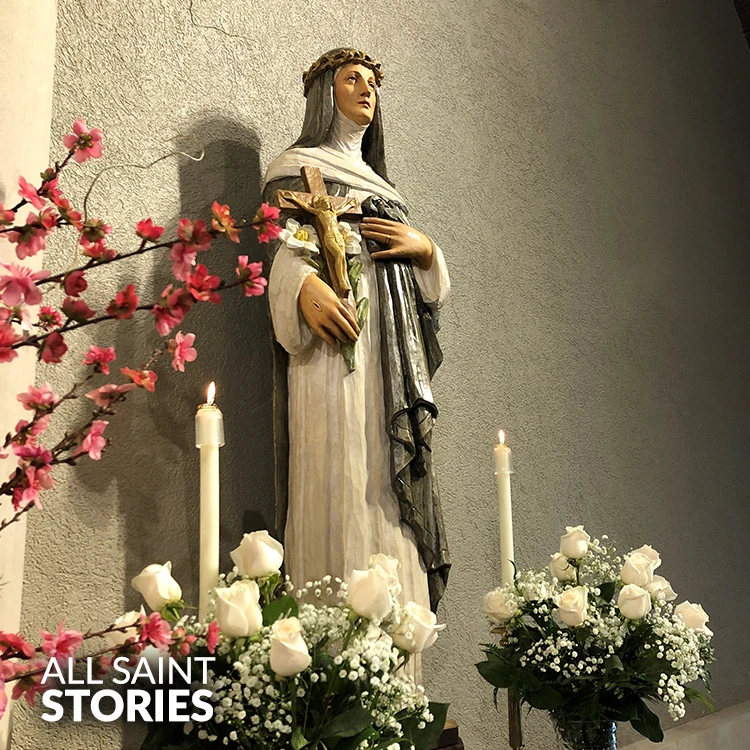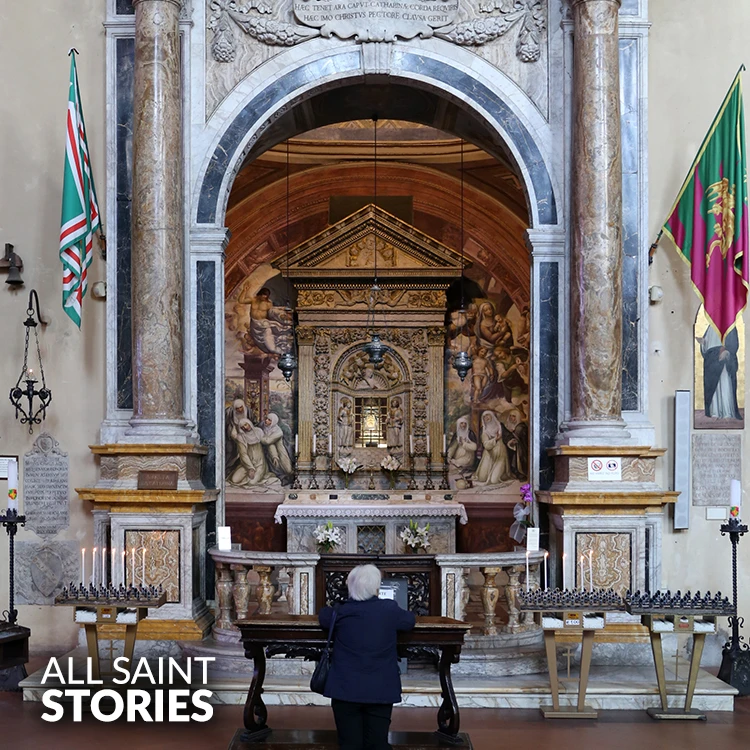Saint Catherine of Siena, faithful servant of God, inspire us with your unwavering devotion and love for Christ. Teach us to trust in divine mercy, remain steadfast in prayer, and serve others with humility. Guide us to follow God's will and embrace His grace in all circumstances. Through your intercession, may we grow in holiness and bring peace to those in need. Amen.
ST. CATHERINE OF SIENA
ST. CATHERINE OF SIENA

St. Catherine of Siena, a Dominican mystic and theologian, was born in 1347 in Siena, Italy. Known for her deep spirituality and wisdom, she dedicated her life to prayer, fasting, and service to the sick. She played a vital role in Church reform and influenced Pope Gregory XI’s return to Rome. Catherine’s writings, including The Dialogue, remain influential in Christian spirituality. She received the stigmata, though it remained invisible at her request. Canonized in 1461, she was later declared a Doctor of the Church in 1970. She is the patron saint of Italy and invoked for protection against illness and fire.
St. Catherine of Siena was born on March 25, 1347, in Siena, Italy, as the youngest of 25 children in a wool-dyer’s family. From a young age, she exhibited an extraordinary connection with God, experiencing divine visions by the age of six. Determined to devote herself entirely to Christ, she resisted her family’s attempts to arrange a marriage and, instead, embraced a life of deep prayer and austerity. At 16, she joined the Dominican Third Order and spent several years in seclusion, dedicating herself to meditation and fasting.
Catherine devoted herself to serving the sick and poor, particularly those suffering from leprosy and the plague. Despite facing ridicule and opposition, she continued her work with unwavering faith. Her reputation for holiness and wisdom spread quickly, drawing followers and influential figures, including Church leaders. She survived on minimal food, often receiving the Eucharist as her sole sustenance. Her spiritual counsel was sought after by both clergy and laypeople, and she became a trusted advisor to the Pope himself.
During a period of great turmoil in the Church, Catherine played a critical role in political and ecclesiastical affairs. At a time when the papacy had moved to Avignon, France, she fervently advocated for its return to Rome. Through her letters and personal intervention, she convinced Pope Gregory XI to reestablish the papal seat in Rome in 1377. Her influence did not stop there; she also worked tirelessly to promote unity within the Church and mediate conflicts between warring factions.
In 1375, Catherine received the stigmata, the marks of Christ’s Passion, but at her request, they remained invisible to others. Despite her physical suffering, she continued her mission with boundless energy. She dictated The Dialogue, a theological work detailing her conversations with God, which remains a cornerstone of Catholic spirituality.
As she neared the end of her life, Catherine offered herself as a sacrifice for the unity of the Church. In early 1380, she suffered a severe illness, which left her unable to eat or drink. Despite her suffering, she continued to pray and serve others. She passed away on April 29, 1380, at the age of 33. Her body was buried at the Basilica of Santa Maria sopra Minerva in Rome, where it remains a site of veneration.
St. Catherine of Siena was canonized in 1461 by Pope Pius II and was later declared a Doctor of the Church by Pope Paul VI in 1970, one of only a few women to receive this title. She is honored as the patron saint of Italy and Europe and is invoked for protection against illness, fire, and political strife.
Video Not Found
The information on this website is compiled from various trusted sources. While we aim for accuracy, some details may be incomplete or contain discrepancies.
If you notice any errors or have additional information about this saint, please use the form on the left to share your suggestions. Your input helps us improve and maintain reliable content for everyone.
All submissions are reviewed carefully, and your personal details will remain confidential. Thank you for contributing to the accuracy and value of this resource.
Credits & Acknowledgments
- Anudina Visudhar (Malayalam) – Life of Saints for Everyday
by Msgr. Thomas Moothedan, M.A., D.D. - Saint Companions for Each Day
by A. J. M. Mausolfe & J. K. Mausolfe - US Catholic (Faith in Real Life) – Informational articles
- Wikipedia – General reference content and images
- Anastpaul.com – Saint images and reflections
- Pravachaka Sabdam (Malayalam) – Saint-related content and insights
We sincerely thank these authors and platforms for their valuable contributions. If we have unintentionally missed any attribution, please notify us, and we will make the correction promptly.
If you have any suggestion about ST. CATHERINE OF SIENA
Your suggestion will help improve the information about this saint. Your details will not be disclosed anywhere.
© 2025 Copyright @ www.allsaintstories.com








 English
English
 Italian
Italian
 French
French
 Spanish
Spanish
 Malayalam
Malayalam
 Russian
Russian
 Korean
Korean
 Sinhala
Sinhala
 Japanese
Japanese
 Arabic
Arabic
 Portuguese
Portuguese
 Bantu
Bantu
 Greek
Greek
 German
German
 Dutch
Dutch
 Filipino
Filipino